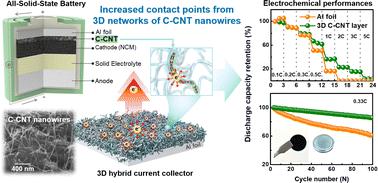当前位置:
X-MOL 学术
›
J. Mater. Chem. A
›
论文详情
Our official English website, www.x-mol.net, welcomes your feedback! (Note: you will need to create a separate account there.)
3D current collector based on cellulose-carbon nanotube nanocomposites for all-solid-state batteries
Journal of Materials Chemistry A ( IF 10.7 ) Pub Date : 2024-08-29 , DOI: 10.1039/d4ta04378b Sejung Park 1 , Young-Woong Song 2, 3 , Boeun Ryu 1 , Hojin Son 1 , Min-Young Kim 3 , Jaekook Kim 2 , Jinsub Lim 3 , Changhun Yun 1
Journal of Materials Chemistry A ( IF 10.7 ) Pub Date : 2024-08-29 , DOI: 10.1039/d4ta04378b Sejung Park 1 , Young-Woong Song 2, 3 , Boeun Ryu 1 , Hojin Son 1 , Min-Young Kim 3 , Jaekook Kim 2 , Jinsub Lim 3 , Changhun Yun 1
Affiliation

|
Recently, lithium-ion batteries (LIBs) have been employed in various applications as a clean power source. In particular, all-solid-state batteries (ASSBs) using non-flammable organic solid electrolytes have attracted extensive interest because they have increased safety and energy density compared to conventional LIBs. Among the many building blocks in an ASSB, the current collector is a bridging element between the LIB electrodes and external circuits and has been developed to achieve enhanced performance in terms of maximum capacity, rate capability, and cycle stability. However, controllable, reproducible, and efficient current collectors have yet to be developed without using complex and costly methods. Herein, we report three dimensional (3D) current collectors for a cathode electrode in ASSBs using an eco-friendly sustainable fabrication method without generating environmentally toxic or harmful chemicals. The 3D hybrid current collector was prepared by bar-coating a 1.5 μm-thick conductive layer with cellulose-SWCNT (C-CNT) nanocomposites on a conventional aluminum (Al) foil. The dispersed C-CNT aqueous solution was fabricated from natural pulp and SWCNT powder using a high-power shaking process. Structural analysis of the dried C-CNT films confirmed that the entanglement and dispersion of C-CNT nanowires determined the mechanical and electrical properties. Moreover, the generated 3D porous structure with the randomly entangled nanowires increased the surface roughness of the C-CNT layer, resulting in improved contact resistance and adhesion bonding strength to the solid-sate cathode active materials in an ASSB. Compared with cells based on a flat Al current collector, the ASSB using a C-CNT layer of 23 wt% SWCNTs (apparent density of 1.16 g cm−3 and electrical conductivity of 180.4 S cm−1) achieved 20% increased discharging capacitance at a C-rate of 0.1C, 163% increased capacity retention at a high C-rate of 1.0C, and 36% increased cycle stability after a 100 cycle test at 0.33C. In addition, the influence of a 3D microstructure on a current collecting layer using C-CNT nanocomposites was carefully analyzed using an adhesion test, cyclic voltammetry, and electrochemical impedance spectroscopy.
中文翻译:

用于全固态电池的基于纤维素-碳纳米管纳米复合材料的3D集流体
最近,锂离子电池(LIB)作为清洁电源已被应用于各种应用。特别是,使用不易燃有机固体电解质的全固态电池(ASSB)引起了广泛的兴趣,因为与传统的锂离子电池相比,它们具有更高的安全性和能量密度。在ASSB的众多构建模块中,集电器是LIB电极和外部电路之间的桥接元件,其开发目的是为了在最大容量、倍率能力和循环稳定性方面实现增强的性能。然而,在不使用复杂且昂贵的方法的情况下,尚未开发出可控、可重复且高效的集电器。在此,我们报告了 ASSB 中阴极电极的三维 (3D) 集电器,采用环保的可持续制造方法,不会产生对环境有毒或有害的化学物质。 3D混合集流体是通过在传统的铝(Al)箔上棒涂1.5微米厚的纤维素-SWCNT(C-CNT)纳米复合材料的导电层来制备的。分散的 C-CNT 水溶液由天然纸浆和 SWCNT 粉末采用高功率振荡工艺制成。对干燥的 C-CNT 薄膜的结构分析证实,C-CNT 纳米线的缠结和分散决定了机械和电性能。此外,生成的具有随机缠绕纳米线的3D多孔结构增加了C-CNT层的表面粗糙度,从而改善了ASSB中固态正极活性材料的接触电阻和粘合强度。与基于平面铝集电器的电池相比,使用 23 wt% SWCNT 的 C-CNT 层的 ASSB(表观密度为 1.16 g cm -3和180.4 S cm -1的电导率)在0.1C的C倍率下实现了20%的放电电容增加,在1.0C的高C倍率下的容量保持率增加了163%,并且循环增加了36%在 0.33C 下进行 100 次循环测试后的稳定性。此外,还使用粘附力测试、循环伏安法和电化学阻抗谱仔细分析了 3D 微观结构对使用 C-CNT 纳米复合材料的集流层的影响。
更新日期:2024-08-29
中文翻译:

用于全固态电池的基于纤维素-碳纳米管纳米复合材料的3D集流体
最近,锂离子电池(LIB)作为清洁电源已被应用于各种应用。特别是,使用不易燃有机固体电解质的全固态电池(ASSB)引起了广泛的兴趣,因为与传统的锂离子电池相比,它们具有更高的安全性和能量密度。在ASSB的众多构建模块中,集电器是LIB电极和外部电路之间的桥接元件,其开发目的是为了在最大容量、倍率能力和循环稳定性方面实现增强的性能。然而,在不使用复杂且昂贵的方法的情况下,尚未开发出可控、可重复且高效的集电器。在此,我们报告了 ASSB 中阴极电极的三维 (3D) 集电器,采用环保的可持续制造方法,不会产生对环境有毒或有害的化学物质。 3D混合集流体是通过在传统的铝(Al)箔上棒涂1.5微米厚的纤维素-SWCNT(C-CNT)纳米复合材料的导电层来制备的。分散的 C-CNT 水溶液由天然纸浆和 SWCNT 粉末采用高功率振荡工艺制成。对干燥的 C-CNT 薄膜的结构分析证实,C-CNT 纳米线的缠结和分散决定了机械和电性能。此外,生成的具有随机缠绕纳米线的3D多孔结构增加了C-CNT层的表面粗糙度,从而改善了ASSB中固态正极活性材料的接触电阻和粘合强度。与基于平面铝集电器的电池相比,使用 23 wt% SWCNT 的 C-CNT 层的 ASSB(表观密度为 1.16 g cm -3和180.4 S cm -1的电导率)在0.1C的C倍率下实现了20%的放电电容增加,在1.0C的高C倍率下的容量保持率增加了163%,并且循环增加了36%在 0.33C 下进行 100 次循环测试后的稳定性。此外,还使用粘附力测试、循环伏安法和电化学阻抗谱仔细分析了 3D 微观结构对使用 C-CNT 纳米复合材料的集流层的影响。





































 京公网安备 11010802027423号
京公网安备 11010802027423号